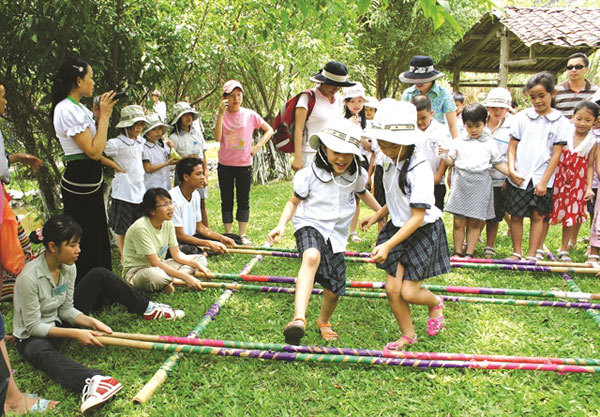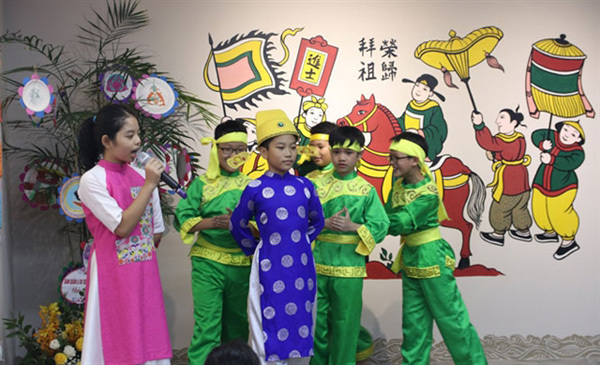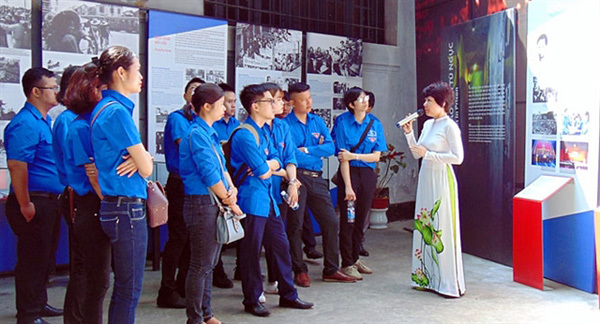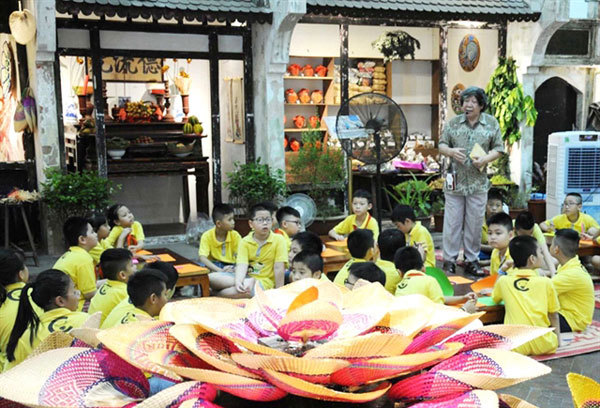 |
|
GAMES PEOPLE PLAY: Students enjoy folk games at the Vietnam Museum of Ethnology in Hanoi. Such activities are part of a heritage education programme at the museum to help enrich students' knowledge about ethnic minorities in the country.
|
Evidence shows that heritage education not only helps promote the value of cultural heritages but also makes destinations much more attractive to tourists.
Many museums and historical relics around town have used the forced “downtime” to improve their offerings and evoke a sense of exploration among tourists, while developing creative new discoveries for domestic visitors, especially given the tumbling number of foreign tourists.
 |
| DRESS-UP: Children role-playing as examination candidates at Van Mieu - Quoc Tu Giam (the Temple of Literature) in Hanoi, as part of a heritage education programme. Photo hanoimoi.com.vn |
The Director of the Van Mieu - Quoc Tu Giam Centre for Cultural and Scientific Activities, Le Xuan Kieu, said heritage education had proven to be increasingly attractive among the public in recent years and this was likely to continue post-pandemic.
“After Van Mieu - Quoc Tu Giam [the Temple of Literature] had to close due to social distancing, the centre promoted its investment in heritage education to better serve Vietnamese visitors,” he said.
“Though they already possess a certain level of knowledge about the country’s heritage, it’s important to provide them with broader experiences.”
“The most popular heritage education programmes run by the centre are those studying the old system of national examinations, discovering the motifs on the stone Stelae of Doctors, printing wooden blocks, and wearing the traditional costumes laureates in the examinations in the past used to wear.”
Conducted in Hanoi since 2012, heritage education tours have found favour in the community and increased the popularity of many museums and historical relics, according to experts.
 |
| LEARNING ON-SITE: heritage education tours of Hoa Lo Prison have been well received by visitors, especially the younger generation. Photo hanoimoi.Com.Vn |
Famous Hanoi destinations such as Van Mieu - Quoc Tu Giam, Thang Long Citadel, and Hoa Lo Prison now have a better reputation in the tourism sector due to their education and exploration tours.
Deputy Director of the Thang Long - Hanoi Heritage Conservation Centre, Nguyen Thanh Quang, said education tours helped the centre expand its offerings.
“The centre had already created interactive spaces for heritage experiences that were suitable for every level of education,” he said. “It is now conducting heritage education projects associated with specific topics, such as increasing students’ knowledge about the history of the Ly, Tran and Le dynasties.”
The goal of the changes to inspire visitors, particularly the younger generation, to explore Vietnam’s culture and history in the most natural way possible.
 |
| OUT OF CLASS: Students visiting the Thang Long Citadel hear about its history. Photo hanoimoi.com.vn |
According to Quang, projects have proven successful and triggered a continuous increase in the number of young visitors, mostly students, on heritage education tours.
“The number of students attended heritage education tour programmes increased to 19,000 in 2019 from about 3,900 in 2018,” he said.
Meanwhile, the Deputy Head of the Hoa Lo Prison Relic management board, Dang Van Bieu, said it now targeted different visitor groups, with a variety of interactive activities held during tours to encourage students and other visitors to be more proactive in discovering the site and to support them in developing skills in teamwork, observation and presentation.
In addition to its regular displays, the Hanoi Museum had been researching and investing in historical and cultural programmes through tours exploring traditional craft villages in and around the capital.
The Principal of the Nguyen Truong To Secondary School in Dong Da District, Hoang Thanh Thuy, said the school had been successfully cooperating for many years with a number of museums and historical relic sites in the city to promote heritage education among students.
“After hours of study in class, students can then participate in various activities during their tour, such as drawing artefacts, trying their hand at being an archaeologist, or meeting with historians, researchers, and folk artisans,” Thuy said.
“Heritage education programmes really have made history lessons much livelier and students find it easier to learn.”
 |
| PROUD HISTORY: Students visit Vietnam Military History Museum and Hanoi Flag Pole. Photo hanoistar.edu.vn |
Nguyen Van Trang, a Grade 10 student at Nguyen Trai High School in Ba Dinh District, said she had become much more interested in history lessons since taking education tours to relic sites in the city.
She found that such tours really opened her mind to the level of historical and cultural development in the capital and elsewhere around Vietnam.
“I’m amazed at how much I’ve learned from tours in museums or at cultural or historical sites,” she said. “What I read in books comes to life on the tours, and I can learn even more from experts.”
Another student, Hoang Anh, from the Hanoi Star School in Thanh Xuan District, said that after listening to experts during a museum tour he became interested in playing folk games and taking part in other activities he had only just heard about.
“That was the best part of the tour, as it made studying history more engaging and memorable,” he said.
Referring to efforts to give heritage education programmes more “vitality”, the Director of the Hanoi Department of Culture and Sports, To Van Dong, said that organisations and agencies involved in historical and cultural tourism should strengthen links among themselves and with universities and schools, so that appropriate programmes would be set up and heritage education would grow in popularity.
According to Le Thi Minh Ly, director of the Centre for Research and Promotion of Cultural Heritage Values at the Vietnam Cultural Heritage Association, on-site heritage education needs to be accompanied by a specialised experience space to be truly effective. Policy changes are also needed to attract more cooperative efforts, and staff must receive in-depth training.
The thousand-year-old Hanoi boasts a treasure trove of cultural and historical heritages both in terms of type and value.
Indeed, Vietnam’s capital is the cradle of some 6,000 cultural and historical relics, more than 2,000 of which have been recognised as national or local heritages.
Items and sites are diverse, including pre-historic military architecture (at An Duong Vuong's citadel, built before 208BC); imperial architecture and artefacts from the Ly Dynasty (10th century) to the Nguyen Dynasty (1802-1945); key areas from the resistance wars against the French and the Americans; and religious spaces, as Hanoi is also a centre of religion, including Buddhism, Mother Goddess worshipping, and Catholicism.
Such strengths provide an environment in which new heritage education programmes would thrive, as more people are now interested in historical events and the unique cultural features of Thang Long - Hanoi.
The sound implementation of education through experience creates both a healthy playground and a method of educating students and enriching their knowledge of national history and culture in a livelier manner.
Moreover, heritage education is also a key solution in preserving and promoting the intrinsic value of Vietnam’s heritages, and at the same time helps them to “live” forever in the hearts of Vietnamese. VNS
Thanh Thuy and Mai Phuong

Smart tourism helps attract visitors to Hanoi
Smart tourism is being applied in a number of tourist attractions in Hanoi such as Bat Trang ceramic village, Thang Long imperial citadel, Van Mieu-Quoc Tu Giam (Temple of Literature - National University) and Hanoi Old Quarter.

Hanoi Flag Tower – the most intact architecture in Thang Long Imperial Citadel
The Hanoi Flag Tower remains undamaged and the most imposing structure in the entire Thang Long Imperial Vestige.
 Heritage education has been effectively used to boost tourism development in Hanoi, particularly since the COVID-19 pandemic caused vast damage to the local and national tourism sector.
Heritage education has been effectively used to boost tourism development in Hanoi, particularly since the COVID-19 pandemic caused vast damage to the local and national tourism sector.